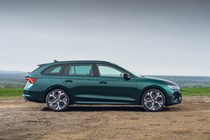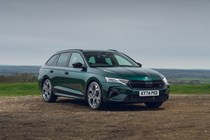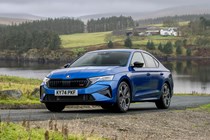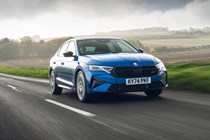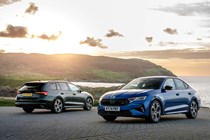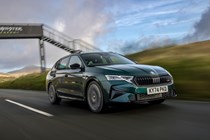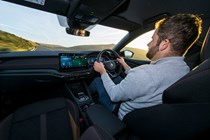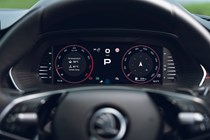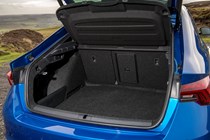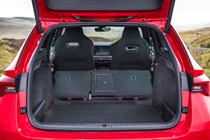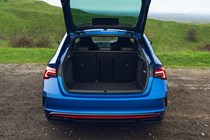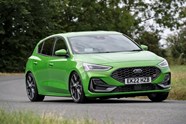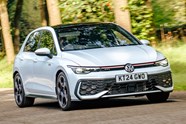
Skoda Octavia vRS review
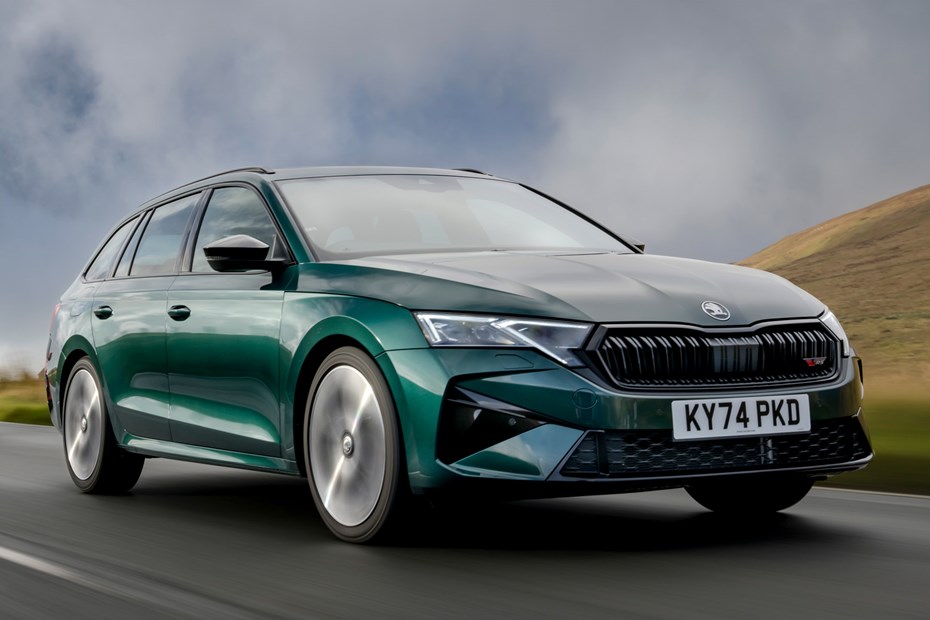
At a glance
| Price new | £39,965 - £41,070 |
|---|---|
| Used prices | £14,207 - £31,968 |
| Road tax cost | £195 - £620 |
| Insurance group | 25 - 27 |
Get an insurance quote with

|
|
| Fuel economy | 38.8 - 56.8 mpg |
| Range | 426 - 673 miles |
| Miles per pound | 5.7 - 7.3 |
| Number of doors | 5 |
| View full specs for a specific version | |
Available fuel types
Petrol
Diesel
Hybrid
Pros & cons
- Practical, easy to live with
- Quick and economical
- Generous standard equipment
- PHEV and diesel vRS discontinued
- No manual version available
- Not the bargain it once was
Skoda Octavia vRS rivals
Overview
If you want a fast, practical yet fairly affordable family car, the Skoda Octavia vRS has long been held in high regard Based on the excellent standard Skoda Octavia – one of the best family cars you can buy – the vRS brings more powerful engines, a more enjoyable driving experience and sportier styling into the mix. No vRS has ever been the last word in excitement, but they’re consistently capable and appeal to more mature drivers. This Octavia continues the tradition.
Available as both a large hatchback and estate, the Octavia vRS has proven a popular choice across its four generations, with more than 45,000 sold in the UK since its introduction in 2001. Following the launch of the current-generation vRS in 2020, it’s now time for a mid-life update, with the vRS gaining similar updates the standard Octavia hatchback and estate received in mid-2024.
The Skoda Octavia vRS is closely related to the Volkswagen Golf GTI and Cupra Leon, with the latter also available as a hatchback or estate. You could also consider the Ford Focus ST (also available in two body styles), which trades some of the vRS’s everyday comfort in the name of a sportier driving experience.

Before the Octavia vRS was facelifted in 2024, you could choose it as a sporty petrol, quick-yet-efficient diesel (which was also available with four-wheel-drive) and also a plug-in hybrid for company car drivers. However, it’s now only the petrol model available, which gets a small power increase to boost performance further, but the recipe largely remains unchanged.
We’ve driven the pre-facelift Octavia vRS extensively, including a six-month extended test, but this is our first drive in the facelift 2024 car. You can find out more about how we test on Parkers via our dedicated explainer page. So should this sporty hatchback and estate still be on your shopping list? It’s time to find out.
What’s it like inside?
The vRS’s interior differs from the standard Skoda Octavia interior in many small ways. You get red stitching, quilted trim, a three-spoke sports steering wheel, and supportive high-backed bucket seats up front. The central infotainment screen is large and easy to use but not without glitches or niggles, and the fresh air vents are mounted too low.
The infotainment’s not been universally liked by us. Editor Keith Adams said in our long-term test, ‘it’s performed a software update on me twice. This means when you start up the car, on the infotainment screen it just says ‘loading settings’ and won’t let you use Apple CarPlay or the radio or sat-nav until it’s finished updating. On one 30-minute journey it meant sitting in complete silence throughout the duration with nothing but my own thoughts to keep me company.’
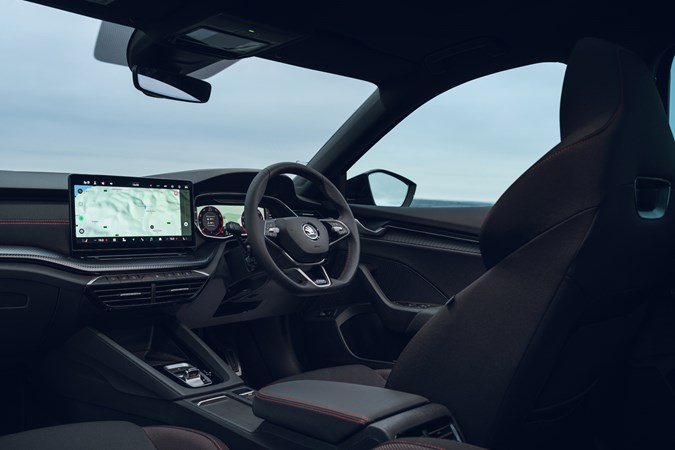
However, Skoda has now updated the infotainment across the full Octavia line-up – including the vRS – with a new 13-inch touchscreen running new software. All our experiences of it so far have been positive, signalling that it’s a welcome improvement. It’s easier and quicker to use than before while, unlike the Volkswagen Golf GTI and Cupra Leon, you still get physical buttons to navigate the climate menu and to turn the windscreen demister on, something we reckon makes it far better to use.
In terms of practicality, it’s a great choice, being a capacious family car, with especially impressive room in the rear. There are a useful number of storage cubbies, while the glovebox is unusually large, too. Overall it’s very impressive.
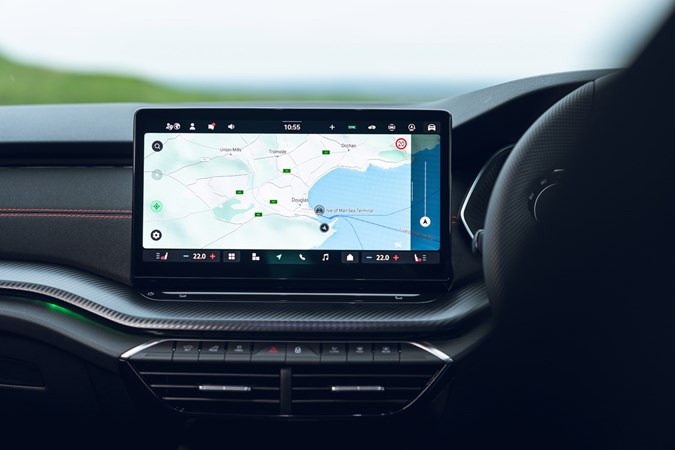
The hatchback’s boot is deep and wide, and extremely well shaped. It offers 600 litres of boot space seats up, and 1,555 litres with them folded. The vRS Estate ups that to 640 and 1,700 litres, which is larger than many cars in the class above. Regardless of which version you go for, you’re unlikely to disappointed by its interior space.
Comfort
We really rate the Octavia’s comfort, and what holds true for the standard version also applies here. Front-seat comfort is particularly good, although the driver’s pew can feel a little flat and unsupportive at first – a long journey soon sorts that.
It’s the same story in the rear – lots of room, slightly flat backrests and excellent long distance comfort. Rear headroom in the estate is better than the hatchback, which reinforces our view the latter version is the better fast family car.
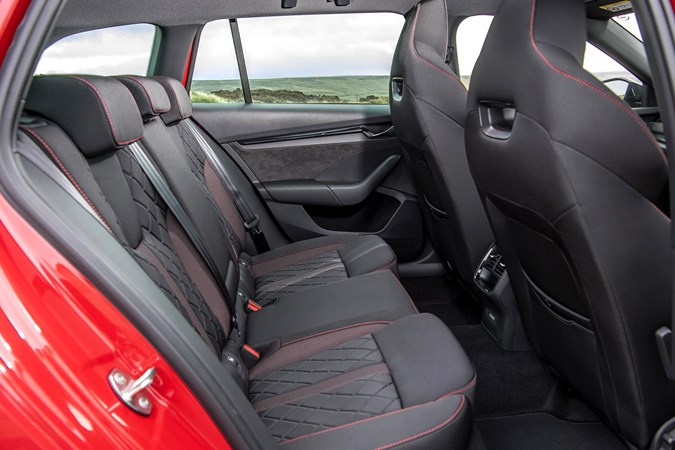
Safety
The Octavia vRS is a five-star Euro NCAP performer, meaning it’s a very safe car. This is one area where this model performs outstandingly well compared with its rivals, and is in no small part down to the technology shared with Volkswagen.
There is an excellent adaptive cruise control system and blindspot monitors as standard as well as collision avoidance tech that will control the car if your concentration or observation wavers. In addition, it will alert you to a potential collision at a junction, and warn you about traffic jams coming up.
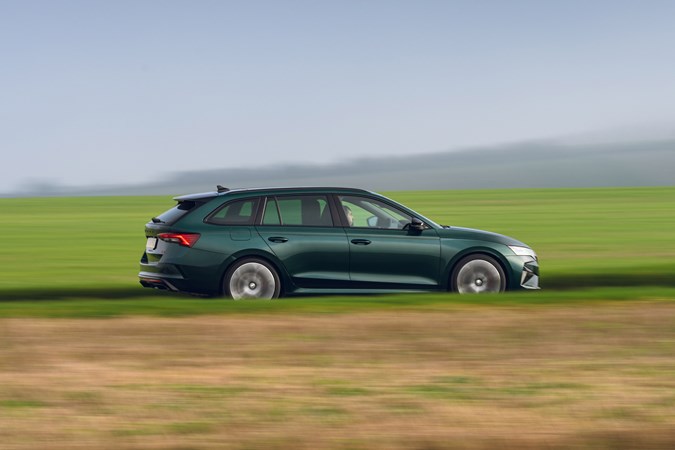
We also rate the Octavia for how easy it is to turn off the often-annoying lane keep assist function – with two presses of a steering wheel button all that’s needed to disable it. In a Golf GTI, you’ll need to rely on the main touchscreen to turn it off, causing a slight distraction.
Petrol engine
The key change on this updated Octavia vRS is its more powerful engine. It’s still the same unit as before, but sees its power increase from 245hp to 265hp, shaving two tenths of a second off its 0-62mph time – taking 6.4 seconds in the hatchback and 6.5 in the estate. Both have a top speed of 155mph.
The petrol is quick, but it’s not enough to shove you into the back of your seat. You can opt for a smoother and more relaxed power delivery in Normal drive mode, which makes use of the torque to gently get you up to speed, and if you switch to Sport, this delivers a more aggressive tune. Skoda has also tweaked the sports exhaust so it’s louder at start-up than before, but not to the extent it will annoy your neighbours.
Diesel engine
The previous 200hp diesel is DSG-only, but you could also opt to have four-wheel drive which is quicker off the line than the front-wheel drive version. The 0-62mph times are 7.1 and 7.6 seconds respectively, while the top speed for both dips slightly to 151mph. The big selling point of the diesel is that it offers a decent turn of pace and 50+mpg on the motorway.
If this is what you really want from a performance family car, it will serve you well, and could be worth finding one on the used market. But if you’re looking for an exciting hot hatch or performance estate then the diesel vRS is not the one to go for. Keith Adams commented in his long-term test, ‘If it’s drama, excitement and a spectacular soundtrack you’re after, you’ll need to look elsewhere. But if – like 99% of drivers rooted in reality – you just want to get places quickly and without attracting attention, the vRS TDI will be right up your street.’
Hybrid engine
The plug-in hybrid vRS iV was available for those looking to reduce their fuel and tax bills, combining a 150hp 1.4-litre petrol with an electric motor to produce a combined 245hp. Like the diesel, this is also available as an automatic only, and takes 7.3 seconds to get from 0-62mph. Top speed is 139mph. Bizarrely considering the increased rise of sportier plug-in hybrids, Skoda axed the vRS PHEV in 2024, with no plans for any reintroduction.
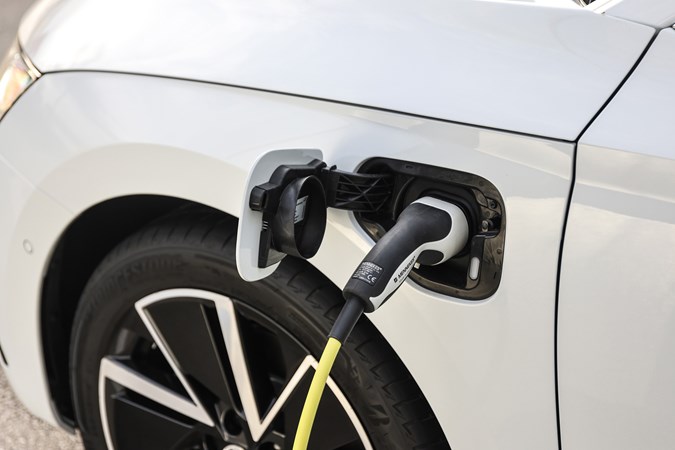
It was probably the weakest of the three anyway, sounding artificial and only capable of genuinely quick acceleration if you’re prepared to nail the throttle – it’s almost the exact opposite of the diesel in terms of effort and reward. But despite that, battery-powered city driving is pleasurable, and it works well as a hybrid in relaxed driving.
What’s it like to drive?
The vRS comes with 15mm lowered suspension, sharpened up steering and an electronic front differential system to help maximise traction. The steering weights up quite nicely in Sport mode and avoids being artificially heavy. The sharpened-up response is good without being nervous or twitchy, and you don’t have to wrestle the steering wheel as the electronic differential tries to manage traction levels between the front wheels. Does it excite or stimulate? Not really, but that’s not really what this car is all about.
We’ve tried the vRS with optional adaptive suspension, which comes as part of the Dynamic Chassis Control package. This adjusts the firmness of the suspension depending on the drive mode, allowing you to favour a softer ride quality or better body control depending on your mood. There’s a noticeable difference between the modes, which isn’t always the case with this option on some cars, and the Octavia isolates occupants from bumps well in its softest Comfort setting. Sport mode firms up the suspension without being too jiggly either. It’s an expensive option at £1,180, however, and one we reckon you can live withou, as the vRS is far from uncomfortable even in its standard guise.
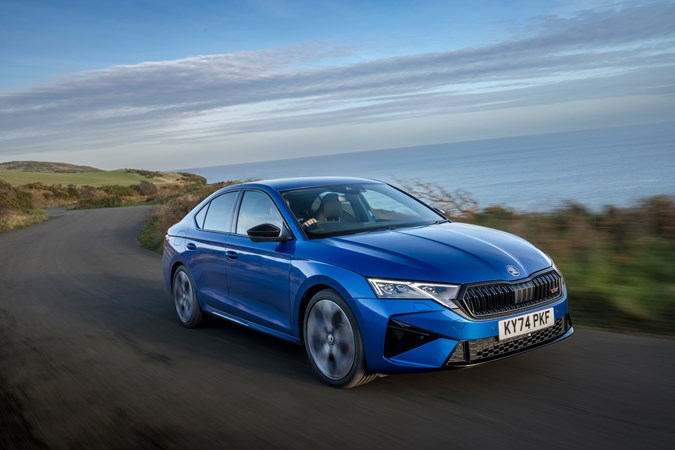
There’s a fair amount of road noise from the 19-inch tyres, but the level of refinement in here remains good enough for long distance comfort. There are no vibrations sent through the steering wheel, seats or floor, and just the occasional bit of wind noise fluttering around the windscreen pillars.
The petrol engine isn’t bursting with character but suits the vRS well, offering plentiful everyday performance for quick overtakes or to tackle fast B-roads with. Skoda used to amplify lots of engine sound through the speakers, but has now taken this away and given the exhaust a fruitier tone instead. It’s still a fairly quiet performance car, but we’d take this over an over-synthesised engine sound.
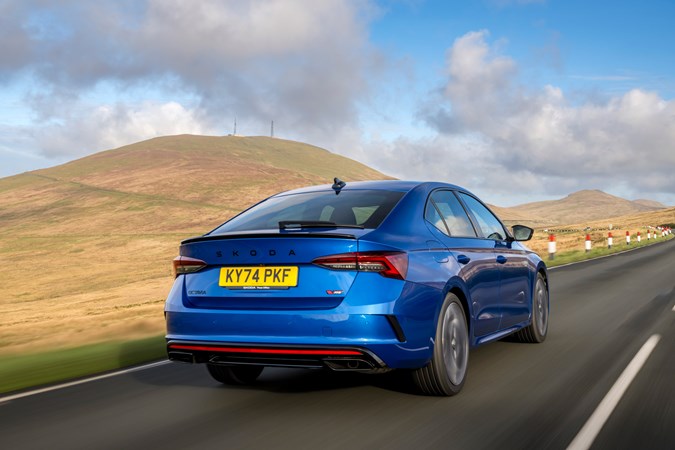
The seven-speed DSG automatic remains smooth and quick to change gears but becomes much more eager to change down in Sport mode for when you need a burst of acceleration. The gearbox hangs onto gears longer before changing up, too, keeping you in the power band for better acceleration, but the vRS is best sampled in Manual mode when you use the steering wheel-mounted paddles.
Overall, there are more thrilling and involving performance hatches out there, but if you just want to get to places quickly in an undemanding way, this will get you there without causing much perspiration.
Ownership costs and reliabbility
The 265hp petrol vRS isn’t the most efficient, but if you drive it steadily, should be able to return 40mpg, particualrly on a motorway run. But if running costs are a priority, we recommend looking at the diesel – or a used plug-in hybrid if you can make the the most of its EV range and aren’t too bothered about sportiness.
The diesel is a 200hp unit that is DSG-only, and this manages up to 55.4mpg or 50.4mpg with four-wheel drive in official testing. We achieved between 49.1mpg and 59mpg in a vRS TDI during our six-month extended test that took in a mixture of motorway and country roads.
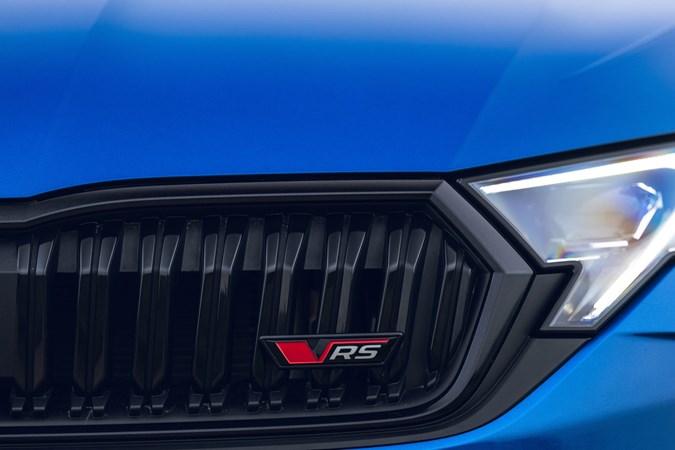
With the vRS plug-in, you’ll need to keep the hybrid battery charged up as often as possible to achieve near its 217.3mpg official figure. Real world range is limited to about 25 miles on battery alone, and it works as an effective hybrid for up to about 100 miles, unless you deploy battery-save mode – which hits overall fuel economy.
The Octavia vRS’s warranty is straightforward – two years unlimited mileage followed by a third year/60,000 miles, whichever comes soonest. There are separate three-year paint and 12-year body warranties too. Reliability is good, although we’d add the caveat that just about every model we’ve driven pre-facelift has suffered from infotainment glitches and crashes.
What models and trims are available?
The choice of which vRS to go for has got much simpler if you’re looking for a new car, with only the one petrol engine available, and now DSG-only. You can still choose it as hatchback or estate car, but we would choose the latter for its even more practical layout. It arguably looks better, too.
Standard equipment on the vRS is plentiful, with all models coming with a 13-inch touchscreen, heated front sports seats, Matrix LED headlights and an electric boot to name just a few highlights.
It really gets all the equipment you need, which is a good thing as the price quickly racks up if you dare look at the options list. Skoda’s extras are normally quite expensive and the vRS is no different. A heated steering wheel will set you back £450, and a panoramic sunroof very pricey at £1,635.
As for the price of the Octavia vRS? It will set you back £37,935 for the hatchback and £39,040 for the estate, meaning it’s not the performance car bargain it once was. That said, it costs similar to a Ford Focus ST in both hatchback and estate guise, despite it being a roomier car. The hatch-only Volkswagen Golf GTI also comes in at around £1,500 more expensive than the Skoda.
So, it’s a great all-rounder, but does that make the Octavia vRS a desirable hot hatchback? Read on for the Parkers verdict.



